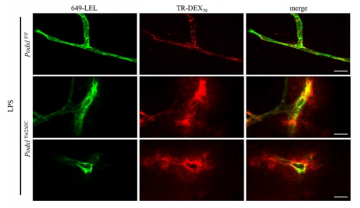 By Bronwyn Lyons, Graduate Student, Strynadka Lab
By Bronwyn Lyons, Graduate Student, Strynadka Lab
Podocalyxin (Podxl) is a protein primarily expressed on the inner surface of blood vessels and specialized kidney cells called podocytes2. Although Podxl plays a critical role in kidney development and function, its purpose in blood vessels has remained cryptic. In a new finding recently published in PNAS1, the McNagny lab (Centre for Blood Research) has determined a new role for Podxl in the maintenance of the blood brain barrier (BBB) during inflammatory disease.
The inner surface of blood vessels is lined with vascular endothelial cells (vECs). Vessels that nourish the brain and central nervous system, have specialized barriers that protect the brain from excess fluid, plasma proteins and toxins. The barrier is reinforced by connections or junctions – composed of protein molecules – positioned between vascular cells. Disruption of these connections, such as during tissue injury, can result in increased BBB ‘leakiness’; this can contribute to the observed pathology of inflammatory diseases, as in the case of a stroke and traumatic brain injury. BBB deterioration is thought to be associated with a worse prognosis for neurodegenerative diseases such as Alzheimer’s disease, consistently one of the major causes of death in Canada3.

Figure 1: Vasculature of mice imaged using fluorescence microscopy. Wild-type (PodxlF/F) and Podocalyxin knockout (PodxlTie2DEC) mice were treated with lipopolysaccharide (LPS). Vasculature was imaged using 649-LEL and permeability was assessed using Texas red (TR) labelled 70-kD dextran (TR-DEX70). The authors describe the permeability as ‘dextran clouds’ in the podocalyxin knockout mice, signifying leakage of dextran outside of the blood vessel. Modified from Figure 4B from Cait et al. (2019).
Cait and colleagues1 used transgenic mice that selectively deletes Podxl in vECs (PodxlTie2DEC) to study the role of this protein in maintaining the BBB during acute inflammation. The authors induced acute inflammation in mice by administering lipopolysaccharides (LPS) – a component of bacterial cell walls – and then monitored changes in permeability of the BBB. ‘Clouds’ of the red dye (TR-DEX70) in Figure 1 indicate areas of leaky vessels in the brains of LPS-treated DPodxl mice, whereas wild-type mice retain their barrier function. As the dye is a relatively large molecule (70 kDa), leakage suggests a serious deficiency in BBB function.
A big downfall related to treatment of neurological diseases is the inability of therapeutics to penetrate the BBB to reach neurological tissue. As part of their study, Cait et al. illustrate that a small molecule is capable of entering the brain in LPS-treated DPodxl mice, as evidenced by a loss of motor function and suppression of brain electrical activity. The authors concluded that Podxl is important in maintaining the integrity of the BBB during acute inflammation, as revealed by the drastic effects observed in DPodxl mice. This research represents an important step in understanding the role of Podxl in BBB function, and the potential for targeting Podxl for either an increase or decrease in function. Cait and colleagues note that activation of Podxl may assist with decreasing the permeability of the BBB in diseases such as multiple sclerosis or stroke, whereas increasing the permeability may help with temporarily opening the BBB to allow therapeutics to reach brain tissue.
Interested in learning more about where this project is going in the future? Check out the Science in the City article here to see a mini-interview with the authors of the paper. Video examples of the behavioral changes can be seen in the article’s supplementary information.
1 Cait J., Hughes M.R., Zeglinski M.R., Chan A.W., Osterhof S., Scott R.W., Hernaez D.C., Cait A., Vogl W., Bernatchez P., Underhill T.M., Granville D.J., Murphy T.H., Roskelley C.D. and McNagny K.M. (2019) Podocalyxin is required for maintaining blood-brain barrier function during acute inflammation. P.N.A.S. 116: 4518-4527.
2 Nielsen J.S. and McNagny K.M. (2009) The role of podocalyxin in health and disease. J. Am. Soc. Nephrol. 20: 1669-1676.
3 Statistics Canada. Table 13-10-0392-01; Deaths and age-specific mortality rates, by selected grouped causes. https://www150.statcan.gc.ca/t1/tbl1/en/tv.action?pid=1310039201 (accessed March 2019).


